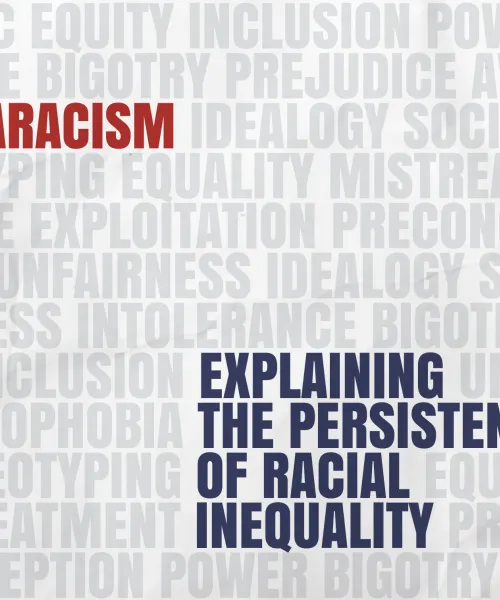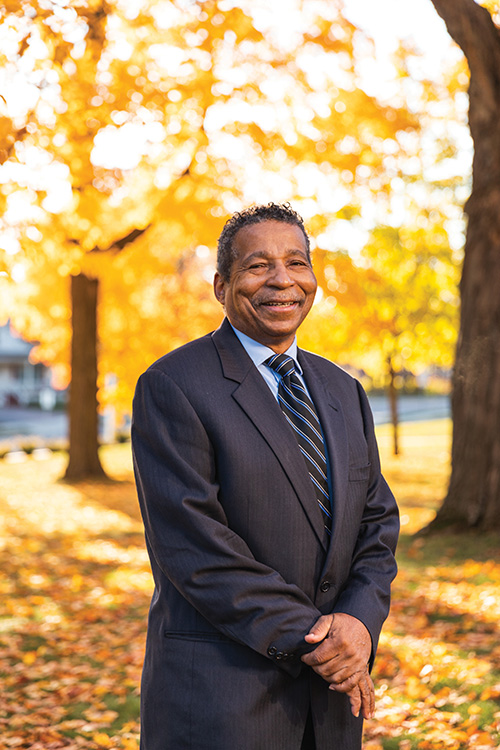
An excerpt from the book by Carter A. Wilson, NMU Political Science Department Head
The twenty-first century promises to be a paradoxical period in U.S. race relations: an age of unparalleled progress, yet of unprecedented repression; an epoch of remarkable racial advancement, yet of persisting racial inequality; a season proclaimed to be one of postracial/post–civil rights politics, yet one of continuing racial strife.
This paradox is not new. It has persisted throughout U.S. history. It has just become more pronounced. This paradoxical combination of progress and regression in terms of conflict between an egalitarian coalition and progressive political culture versus a conservative coalition and a reactionary political culture is energized by a new form of racism—metaracism.
The egalitarian coalition produced progress through the establishment of equal opportunity policies that emerged primarily during the 1960s and 1970s. The conservative coalition produced the regression not by reforming equal opportunity policies, but by assaulting, dismantling, dismembering, or shrinking them. The assault on equal opportunity policies contributed to the reversal of progress, an increase in racial repression, and the widening of the black/white gap in income, education and wealth.
The formation of metaracism arises out of concentrated urban poverty. Metaracism is associated with the development of a bifurcated black class structure; the rise of the black middle and professional class; and the growth of concentrated black poverty isolated in the inner city. Metaracism is a revised, refined, and subtle form of racism.
As the originator of this concept, Joel Kovel, explains, “Metaracism is a distinct and very peculiar modern phenomenon. Racial degradation continues on a different plane, and through a different agency: those who participate in it are not racists—that is, they are not racially prejudiced— but metaracists, because they acquiesce in the larger cultural order which continues the work of racism.”
Metaracism is a form of racism without hateful bigots. It replaces biological determinism with cultural determinism. It no longer dehumanizes all blacks.
It accepts the black middle class, but promotes dehumanizing images and stories of welfare queens, teenage girls having babies to get welfare and black teenage thug culture. It involves the strategic use of race in the assault on progressive policies and the support of extreme inequality. It provides images and narratives that support and boost neoconservative and neoliberal ideologies and that energize reactionary political movements. It operates to legitimize the growth of concentrated black poverty and an increasingly repressive criminal justice system.
The study of racism has long remained outside the purview of traditional disciplines of literature, history, political science and law. Even though it has been an integral part of U.S. culture, the subject has only recently moved to center stage in many of these disciplines.
Understanding the dynamics of past racism is critical to understanding contemporary metaracism. Racism underscores the following principles:
- Race and racism are historical and cultural constructs strongly associated with patterns of oppression and the drive to accumulate wealth.
- The constructions of race and racism typically present dominant and subordinate racial groups as binary opposites.
- These constructs function to legitimize patterns of oppression and to desensitize society to the suffering of the oppressed.
- The constructs of racism and race allow for the formation of white identity, which also functions to reduce class conflict and increase tolerance for extreme inequality.
- Racist perspectives have long been accepted as normal and valid precisely because these perspectives have been promoted, validated, and normalized by religious, intellectual, scientific, political, and media elites.
- While the dynamics of racism are similar, the forms of racism change as their structural, cultural, and political dimensions vary.
The new metaracism is a hodgepodge of new and old stereotypes, images, narratives and ideologies. It supports neoconservatives and neoliberalism and conflates race, ideology and nationalism. Joel Kovel argues that “metaracism exists wherever the ends of the large-scale system of the modern Industrial State are considered more important than the human needs of men.”
The most malicious and oppressive aspect of metaracism arises in the space where race and class intersect. In this space, metaracism demonizes the black poor as being trapped in a culture of poverty and hostile to education and hard work. It portrays concentrated poverty areas as inhabited by a dangerous, predatory, and repulsive underclass and infested with hyper-violent, wild youth gangs that have no regard for human life.
It has shifted the blame for concentrated poverty to the poor themselves. But metaracism did not produce concentrated black poverty; it emerged to legitimize that poverty. Just as racial animus was not the driving cause of the initial construction of the institution of slavery, it was not the primary cause of the growth of concentrated urban poverty. Just as greed and the drive to accumulate wealth contributed to the construction of the institution of slavery, the same greed and drive contributed greatly to the growth of concentrated urban poverty. Just as racism emerged to legitimize slavery, a new form of racism emerged to legitimize concentrated poverty.
In summary, several economic changes created the context out of which metaracism emerged. These economic changes included the drive of the corporate sector to increase profits and accumulate wealth. In pursuit of this drive, corporations consolidated, automated and moved production facilities and manufacturing jobs out of high-wage, unionized, older industrial cities to low-wage, non-union areas, producing economic changes that contributed to economic insecurity and declining wages. These changes began to occur during the 1970s at the same time the black middle class was expanding and leaving inner cities. The exodus of the black middle class from inner cities occurred at the same time these cities were hemorrhaging high-paying manufacturing jobs. The loss of both manufacturing jobs and the middle class contributed to the rise of concentrated urban poverty. The contraction of the manufacturing sector in urban areas and mass farm foreclosures in rural areas generated economic insecurity. These economic changes provided the context out of which metaracism emerged during the first two decades of the 21st century.
Metaracism: Explaining the Persistence of Racial Inequality (2015) is published by Lynne Rienner Publishers, Inc. Excerpted and abridged by permission. Dr. Wilson is currently writing a new book, Trumpism: Race, Class, Populism and Public Policy.

5 Questions with Dr. Carter Wilson

How has the definition or practice of metaracism changed since you published the book in 2015?
This definition of metaracism has not changed. The focus of my research has changed. Metaracism focuses on urban poverty. Trumpism, the book I am currently working on, focuses on rural poverty and the impact of racism on white workers. Racism has always masked extreme inequality. It continues to do so today.
What issues must be immediately addressed to turn the tide?
Extreme inequality must be addressed. Of course, it must be acknowledged before it can be addressed.
What can Northern Magazine readers do to influence racial equity?
Read Jonathan Metzl’s book Dying of Whiteness and Anne Case and Angus Deaton’s book Deaths of Despair and the Future of Capitalism. Incidentally, Angus Deaton earned the 2015 Nobel Prize in economics. Understanding how our larger political economy operates is the key to understanding inequality in general and racial inequality in particular. Racial inequality is not an isolated phenomenon.
What kinds of conversations are you having with your students?
I love my students. They give me hope. My classes are like therapy sessions. I always feel so much better after I finish teaching a class. My students get it. They understand why we need conservatives and liberals and why we need dialogue across ideologies.
What wakes you up at night, or gives you peace?
The report of the plot to kidnap Governor Gretchen Whitmer keeps me up. NMU students give me peace.
